- Home
- Blog
- Home Services
- 2026 Roofing Marketing Benchmarks to Build Your Campaigns On
2026 Roofing Marketing Benchmarks to Build Your Campaigns On
-
 Published: Oct 10, 2025
Published: Oct 10, 2025
-
 16 min. read
16 min. read
-
Summarize in ChatGPT
-
 Matthew Gibbons
Matthew Gibbons Senior Data & Tech Writer
Senior Data & Tech Writer
- Matthew Gibbons is a Senior Data & Tech Writer at WebFX, where he strives to help businesses understand niche and complex marketing topics related to SEO, martech, and more. With a B.A. in Professional and Public Writing from Auburn University, he’s written over 1,000 marketing guides and video scripts since joining the company in 2020. In addition to the WebFX blog, you can find his work on SEO.com, Nutshell, TeamAI, and the WebFX YouTube channel. When he’s not pumping out fresh blog posts and articles, he’s usually fueling his Tolkien obsession or working on his latest creative project.

Key roofing marketing benchmarks to know
Roofing marketing benchmarks are key performance metrics that represent industry standards. You can measure your own metrics against these benchmarks to get a sense of how well your marketing campaigns are performing.
Here are some of the most essential roofing marketing benchmarks to know:
- Cost per lead (CPL): $350
- Conversion rate: 5.58%
- Sales cycle length: 30 days
- Cost per click (CPC): $25–$50
- Net profit margin: 12.27%
By tracking each of these metrics and measuring them against the average, you can more effectively reach your target audience, earn more jobs, and increase your overall revenue.
You’ve tracked your conversion rate. You’ve calculated your ROI. You’ve even figured out your average sales cycle length. But looking at the numbers in front of you, you find yourself wondering what their significance is for your roofing business. Is your 7% conversion rate good? Bad? Average? You don’t know.
The issue is that you don’t have a standard by which to judge your metrics. To see where those metrics should be, you need industry averages to compare them to. That’s why we’ve put together this page to walk you through some of the most important roofing marketing benchmarks to know.
What are roofing marketing benchmarks (and why do they matter)?
Roofing marketing benchmarks are marketing performance metrics that represent roofing industry standards. That is, they show the industry-wide averages for specific metrics. The roofing cost per lead (CPL) benchmark, for example, shows the average CPL across all roofing companies in the industry.
The purpose of these benchmarks is to give you a standard by which to judge your own roofing company’s marketing performance. If some of your metrics are coming in lower than the industry benchmarks for those same metrics, you know you’re performing below average compared to your competitors.
Based on that information, you can then reoptimize your marketing campaigns and keep an eye on your performance indicators to see which changes lead to better results. Additionally, roofing marketing benchmarks enable you to:
- Set a better marketing budget by studying CPL, CPC, and ROI industry averages
- Set realistic campaign goals based on hard data from roofers across the industry
- Keep up with the competition among other roofers in your local area
- Prioritize the right channels by learning which marketing sources deliver the highest ROI
Vital roofing benchmarks to keep an eye on
We’ve talked about the importance of roofing marketing benchmarks — now let’s move on to the benchmarks themselves. We’ll start with a summary of the most important metrics to know, and then we’ll walk through them in more detail. This page will focus on five main benchmark categories:
- Search engine marketing opportunities
- Content marketing gaps and opportunities
- Digital marketing channel performance
- Competitive landscape analysis
- Seasonal demand and market timing
Get more info about each one below.
Roofing marketing benchmarks summary
If you’re not looking to get into the nitty-gritty details just yet, but prefer a broader picture of industry marketing benchmarks, we’ve got you covered. Below are some of the most crucial benchmarks to know at a glance.
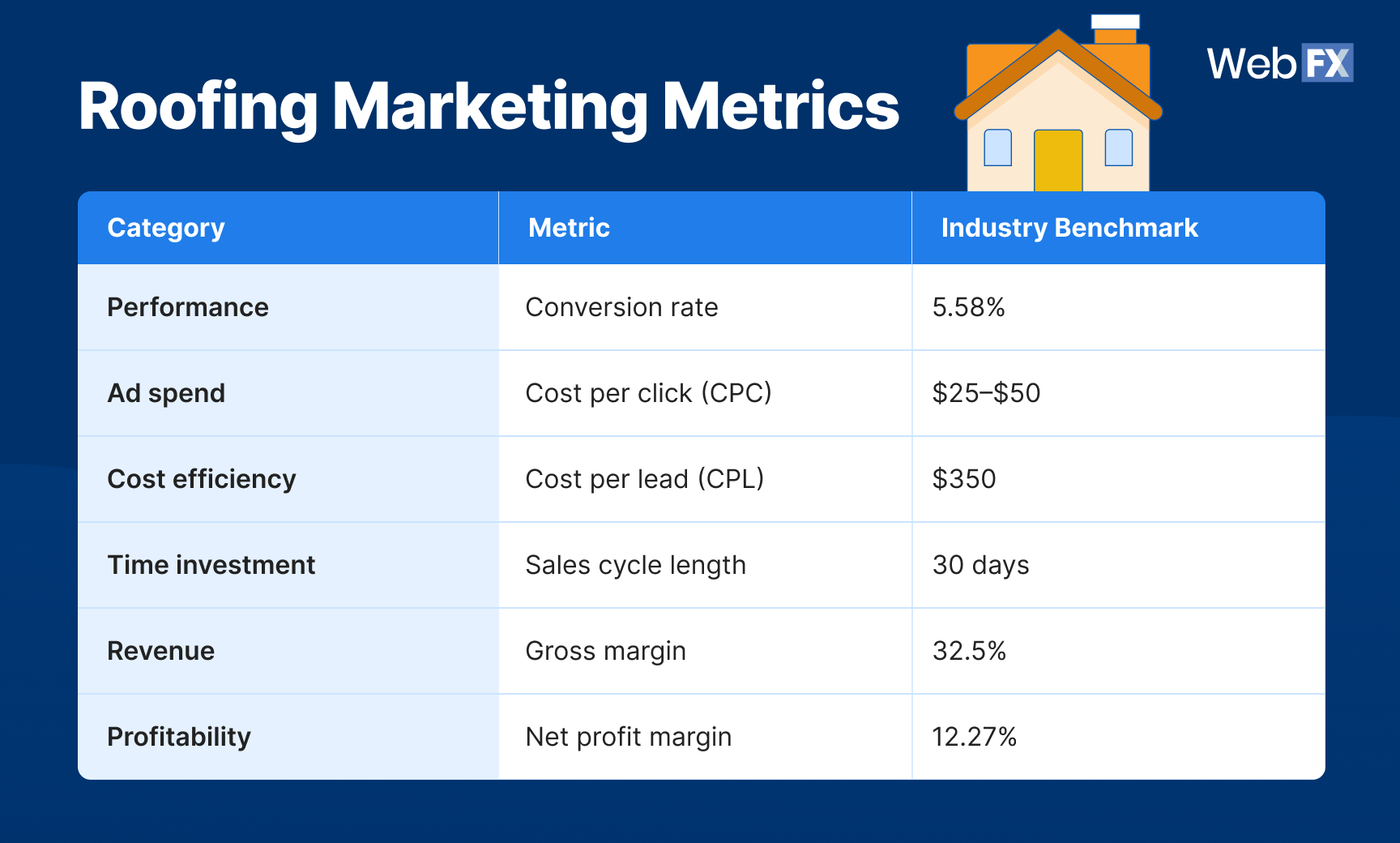
🔽 View table
| Category | Metric | Industry benchmark |
| Performance | Conversion rate | 5.58% |
| Ad spend | Cost per click (CPC) | $25–$50 |
| Cost efficiency | Cost per lead (CPL) | $350 |
| Time investment | Sales cycle length | 30 days |
| Revenue | Gross margin | 32.5% |
| Profitability | Net profit margin | 12.27% |
Now let’s get into some more specific benchmark categories.
1. Search engine marketing opportunities
Promoting your roofing business in Google search results is vital for reaching your target audience online and earning more jobs. This data will help illuminate your approach to search-based strategies like search engine optimization (SEO) and pay-per-click (PPC) advertising.
Below are some examples of high-volume roofing queries, along with data on volume, difficulty, CPC, and search intent.
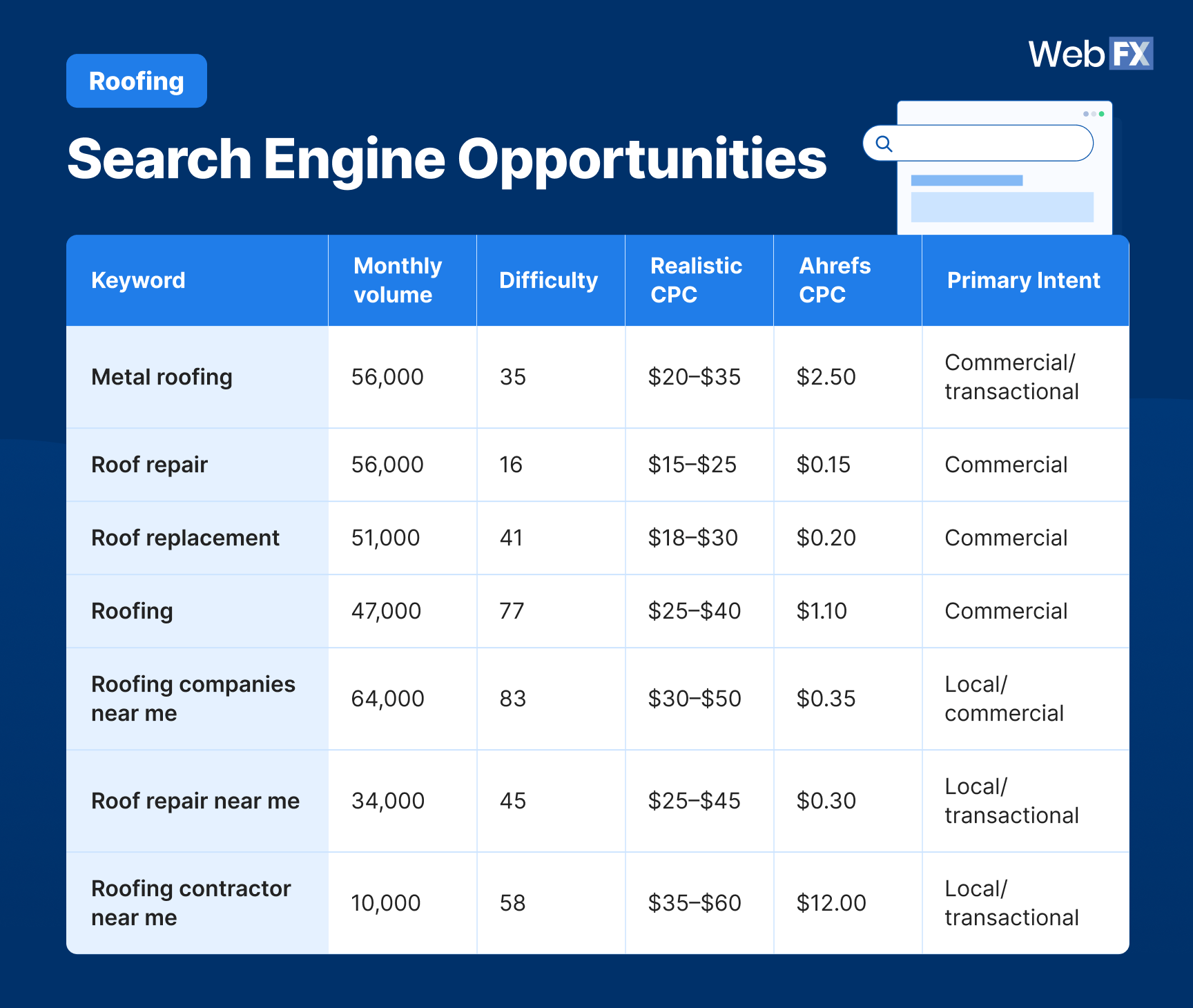
🔽 View table
| Keyword | Monthly volume | Difficulty | Realistic CPC | Ahrefs CPC | Primary Intent |
| Metal roofing | 56,000 | 35 | $20–$35 | $2.50 | Commercial/transactional |
| Roof repair | 56,000 | 16 | $15–$25 | $0.15 | Commercial |
| Roof replacement | 51,000 | 41 | $18–$30 | $0.20 | Commercial |
| Roofing | 47,000 | 77 | $25–$40 | $1.10 | Commercial |
| Roofing companies near me | 64,000 | 83 | $30–$50 | $0.35 | Local/commercial |
| Roof repair near me | 34,000 | 45 | $25–$45 | $0.30 | Local/transactional |
| Roofing contractor near me | 10,000 | 58 | $35–$60 | $12.00 | Local/transactional |
You might notice that there are two different columns for CPC. That’s because our data shows a major discrepancy in keyword research tools like Ahrefs. These tools offer unrealistically low CPCs — 10–20 times too low, in fact! — leading roofers that use those tools to underbudget for their paid ad campaigns.
This happens for a few reasons. For one, high contractor density drives up paid ad bidding, and seasonal spikes in storm seasons can even double or triple typical ad costs. Additionally, local roofing markets tend to have CPCs several times higher than national averages.
That means when you’re planning out your search engine strategy, you shouldn’t rely on keyword tools to predict your ad costs. If you’re wondering what sorts of costs you can actually expect, here are some typical CPC ranges for different keyword intents:
- Premium Local Terms: $25–$40
- Standard Commercial Terms: $15–$30
- Informational Terms: $8–$20
Biggest takeaway for roofers: Roofing search engine marketing is far more expensive than tools like Ahrefs indicate. However, the right keyword targeting strategy can still allow you to compete profitably.
2. Content marketing gaps and opportunities
A good SEO strategy requires valuable roofing content that you can optimize to rank in search engines. But you might be in the dark about the best way to publish that content — how much, how often, and what kind, among other things.
Let’s start by taking a look at how roofers are currently approaching their blog content strategy, differentiating between major roofing manufacturers and local contractors.
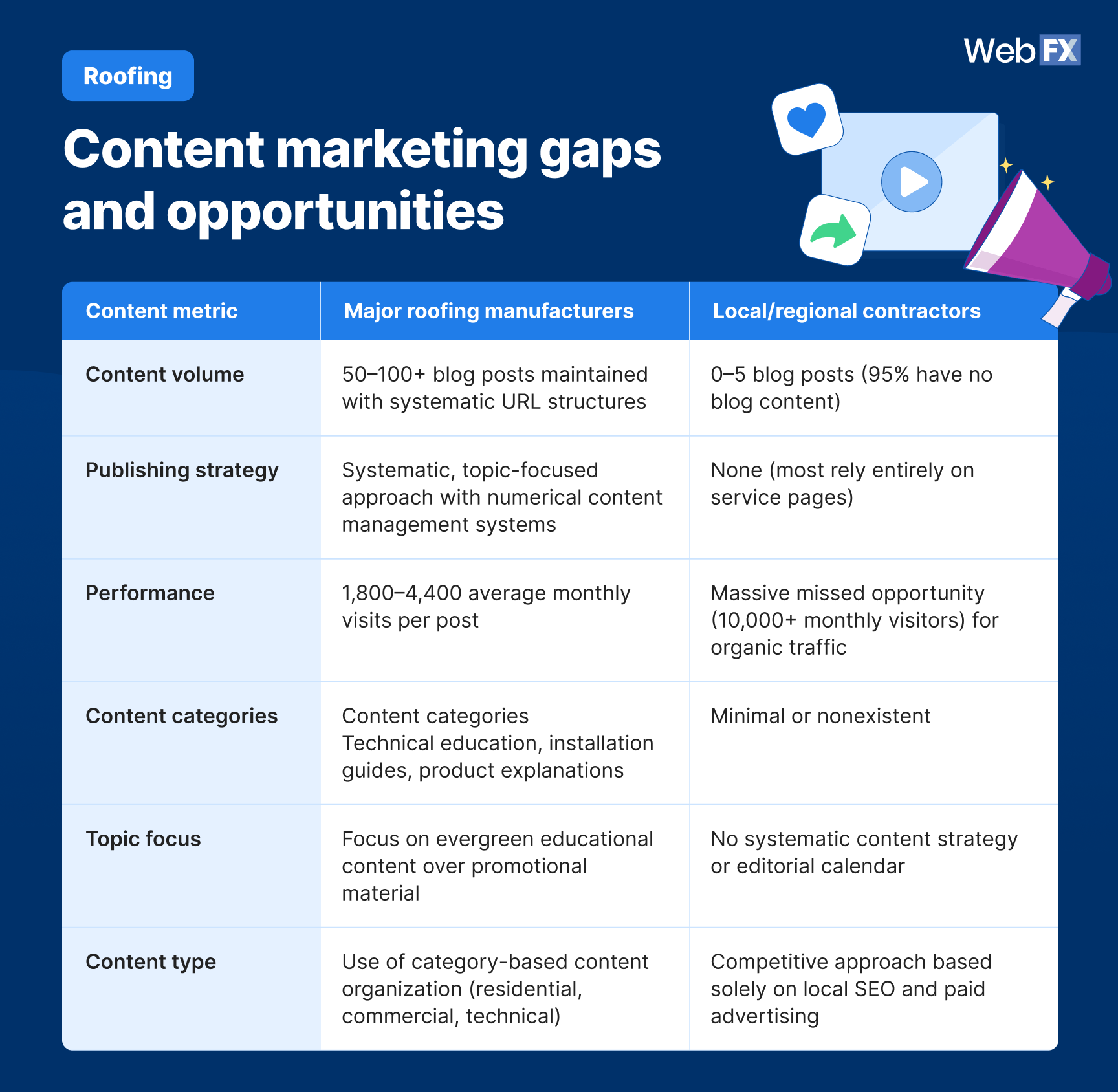
🔽 View table
| Content metric | Major roofing manufacturers | Local/regional contractors |
| Content volume | 50–100+ blog posts maintained with systematic URL structures | 0–5 blog posts (95% have no blog content) |
| Publishing strategy | Systematic, topic-focused approach with numerical content management systems | None (most rely entirely on service pages) |
| Performance | 1,800–4,400 average monthly visits per post | Massive missed opportunity (10,000+ monthly visitors) for organic traffic |
| Content categories | Technical education, installation guides, product explanations | Minimal or nonexistent |
| Topic focus | Focus on evergreen educational content over promotional material | No systematic content strategy or editorial calendar |
| Content type | Use of category-based content organization (residential, commercial, technical) | Competitive approach based solely on local SEO and paid advertising |
As you can see from the data above, the vast majority of local roofers are missing out big time on the search traffic they could be generating. Your company is likely included in that majority.
The good news is, there’s a huge opportunity here. Most of your competitors are missing out on traffic just as much as you are, so if you’re the first to build a strong content strategy and boost your search visibility, you can leave those competitors in the dust. Simply publishing any content at all immediately puts you at the front of the pack.
What’s the best way to do that, though? Here are some data-backed recommendations for your blog publishing strategy, broken down over time:

🔽 View table
| Timeframe | Frequency | Focus | Goal |
|---|---|---|---|
| Months 1–3 | 2 posts per month | High-traffic educational topics (Tier 1) | Establish authority and capture search traffic |
| Months 4–6 | 3 posts per month | Mix of Tier 1 and Tier 2 topics | Expand keyword coverage and topic authority |
| Months 7+ | 4+ posts per month | Comprehensive topic coverage including Tier 3 | Dominate local search for roofing education topics |
Of course, you can vary this strategy depending on what works best for your roofing business.
Biggest takeaway for roofers: Content marketing is a vastly untapped source of growth for local roofers. Simply by putting out consistent content on your website, you can earn thousands of site visitors and gain a huge advantage over your competitors.
3. Digital marketing channel performance
A good digital marketing strategy will use multiple online channels together, but which of those channels is the most valuable for roofing companies? That’s the first question we’ll be answering with the data shown below.
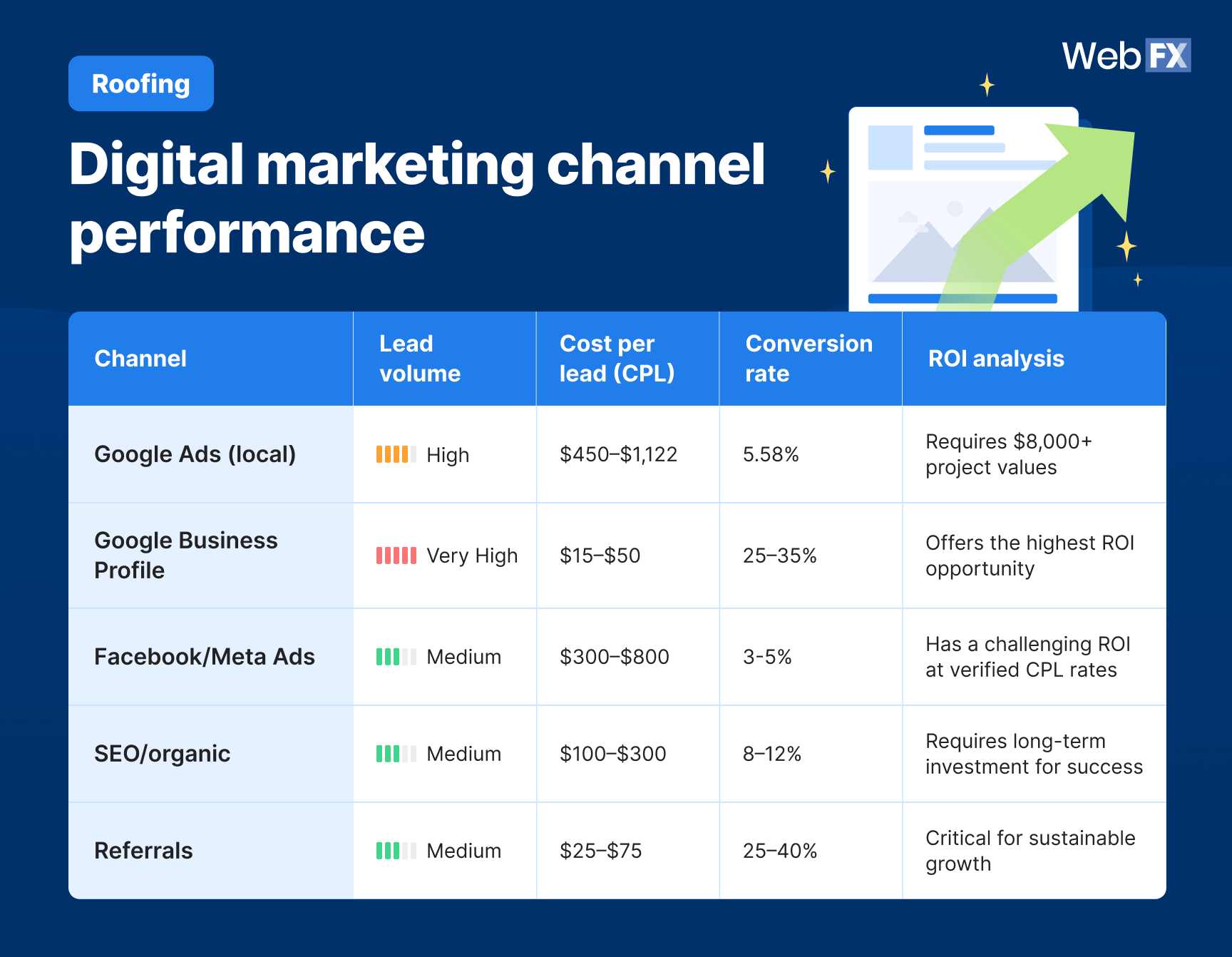
🔽 View table
| Channel | Lead volume | Cost per lead (CPL) | Conversion rate | ROI analysis |
| Google Ads (local) | High | $450–$1,122 | 5.58% | Requires $8,000+ project values |
| Google Business Profile | Very high | $15–$50 | 25–35% | Offers the highest ROI opportunity |
| Facebook/Meta Ads | Medium | $300–$800 | 3–5% | Has a challenging ROI at verified CPL rates |
| SEO/organic | Medium | $100–$300 | 8–12% | Requires long-term investment for success |
| Referrals | Medium | $25–$75 | 25–40% | Critical for sustainable growth |
There are a few insights we can take away from that data, including the following:
- Cost per lead is highest for Google Ads. Since we’ve already talked about how ad CPC tends to be much higher than shown in keyword research tools, it’s no surprise that CPL is higher, too.
- Google Business Profile has the highest ROI. This makes sense — local SEO is essential for roofers, most of whom operate in a specific local area, and your Google Business Profile is a big part of that strategy.
- Referrals are low-cost and high-converting. Despite being one of the cheapest strategies, referral marketing has one of the highest conversion rates, placing it among the most valuable roofing marketing strategies.
Biggest takeaway for roofers: Spending more on ads isn’t always the best ticket to victory. You should pair your advertising campaigns with local SEO and referral marketing if you want to see high conversion rates without going vastly over your budget.
4. Competitive landscape analysis
Your marketing success rests on your ability to outperform your competitors, particularly other local roofers in your area. But to have a good chance at beating them, you need to know what they’re doing. That’s where competitor analysis comes in.
You can (and should!) do your own analysis on the specific competitors you’re going up against. But to get you started, we have some data related to the level of competition you can expect in different areas and subsectors.
Firstly, there are specific markets that have higher (or lower) competition than others. According to our research, you can expect to find higher competition in urban areas with over 50 roofing contractors per 100,000 people.
On the flip side, here are some markets that come with lower competition, therefore representing emerging opportunities for your roofing company:
- Commercial and industrial sectors
- Suburban expansion areas with growing housing stock
- Post-disaster recovery regions with insurance claim opportunities
Additionally, competition level varies among different roofing subsectors. Here’s a breakdown of the data:

🔽 View table
| Subsector | Competition level | Keyword difficulty | Cost per click (CPC) | Analysis |
| Residential reroofing | High | 35–45 | $0.15–$3.00 | Success requires local SEO excellence and reputation management |
| Commercial roofing | Medium | 20–30 | $0.15–$2.00 | Longer sales cycles but higher project values |
| Emergency/storm services | Low | 0–15 | $4.00–$15.00 | High conversion rates and premium pricing opportunities |
As you can see, competition is highest in urban and residential markets, while it’s lower in post-disaster and emergency storm markets. That gives you a sense of direction when you’re looking at which areas or keywords to target with your digital marketing.
Biggest takeaway for roofers: Competing in highly saturated residential markets can be both expensive and difficult. For a better ROI and lower competition, consider targeting more rural, commercial, and emergency markets over urban or residential ones.
5. Seasonal demand and market timing
As any roofer knows, seasonality plays a big role in the process of earning jobs. Storm season brings a lot of roof damage, and that leads to more people seeking out roofing services. According to our data, here’s what you can expect from different seasons during the average year:
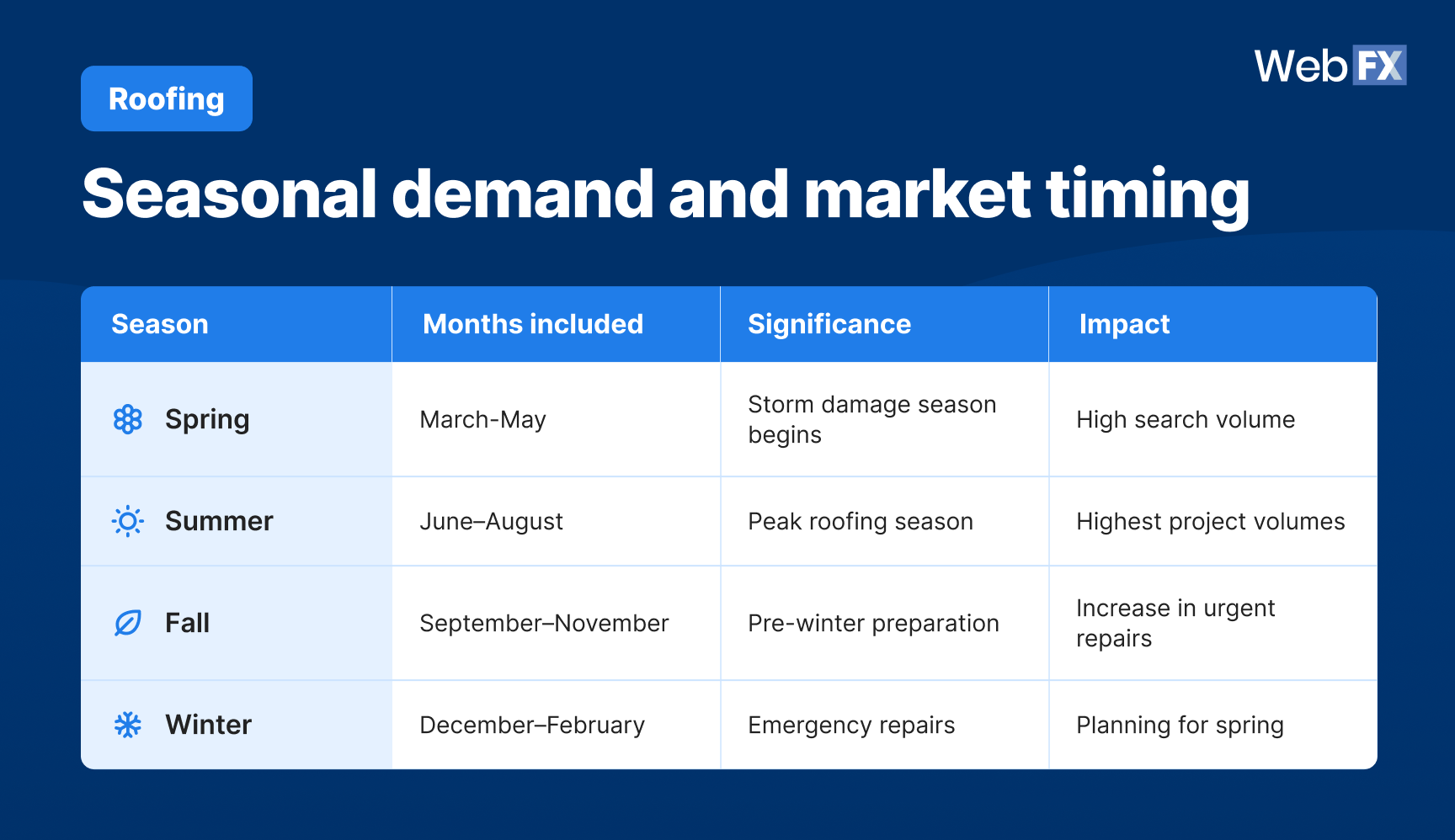
🔽 View table
| Season | Months included | Significance | Impact |
| Spring | March–May | Storm damage season begins | High search volume |
| Summer | June–August | Peak roofing season | Highest project volumes |
| Fall | September–November | Pre-winter preparation | Increase in urgent repairs |
| Winter | December–February | Emergency repairs | Planning for spring |
Based on that seasonal fluctuation, it’s better for roofers to focus on different areas of their marketing during different months. Here are some of the most ideal strategies to emphasize during each month, based on our data:

🔽 View table
| Month(s) | Recommended strategies |
| January–February | Content marketing, SEO improvements, planning |
| March–May | Peak advertising spend, emergency services focus |
| June–August | Brand awareness, customer retention, referral programs |
| September–November | Maintenance messaging, winter preparation |
| December | Holiday marketing pause, planning for next year |
As you can see, it’s important to really ramp up your marketing when storm season hits. On the other hand, the end of the year is the time to put things on pause and lay out your marketing plans for the following year. Disrupting this cadence — for example, doing a lot of marketing in December or slacking off in April — will result in wasted marketing spend and missed opportunities.
That said, the offseason is a good time to work on your SEO and content marketing, since those strategies take time to drive results. If you publish some good blog content in December, for example, it may start driving results by the time you hit peak storm season a few months later.
Biggest takeaway for roofers: Roofing marketing is as much about when you spend as it is how much you spend. By aligning your strategy with varying seasonal demands, you can maximize your marketing spend and outperform any competitors that use the same approach year-round.
Strategic recommendations for roofers
Having access to roofing marketing benchmarks is great, but they’re not much use to you if you don’t know what to do with them. That’s why, based on the roofing data we’ve collected, we’ve put together a list of actionable recommendations to help you level up your marketing.
Those recommendations are:
- Make your Google Business Profile your top priority
- Promote your emergency services
- Take advantage of content marketing opportunities
- Fix revenue leakage from missed calls
Let’s look at each of those tips in a bit more detail.
1. Make your Google Business Profile your top priority
Creating a Google Business Profile is one of the most essential components of local SEO, which is a strategy vital to any roofer operating in a specific local area. Furthermore, as we’ve already seen, Google Business Profile has the highest ROI out of all major roofing marketing channels.
For both of those reasons, you should prioritize Google Business Profile optimization above all your other marketing strategies. Your first order of business should be to get your profile up and running so you can start appearing in local searches.
2. Promote your emergency services
Given the importance of seasonality in the roofing industry — driven mainly by storm damage that takes place during certain parts of the year — emergency services offer a high-margin opportunity for roofers. You can take advantage of this by creating dedicated storm damage pages on your website to capture traffic looking for emergency repairs.
These pages should be accompanied by information related to insurance claims, 24/7 response systems, and more to ensure that you retain urgent leads and get back to them quickly.
3. Take advantage of content marketing opportunities
We’ve already covered how few roofing contractors actually bother to publish content on their websites. As a result of that, content marketing is one of the most effective marketing strategies you can implement, and it represents an opportunity to get way ahead of your competitors.
You can create lots of different content types, including:
- Educational roofing repair guides
- Emergency storm checklists
- Storm season preparation tips
4. Fix revenue leakage from missed calls
One roofing statistic we haven’t looked at so far on this page is that 27% of all calls are missed across the roofing industry. That means you’re likely losing out on a lot of potential leads, and if you want to upgrade your marketing strategy, you should optimize accordingly.
Start by bolstering your call response team, perhaps by bringing on some new customer representatives to take those calls. Once you’ve done that, you should also consider implementing more advanced call answering services, call tracking software, or AI-driven text follow-ups to help you immediately recapture any leads whose calls you do miss.
FAQs about roofing marketing benchmarks
Here are the answers to some commonly asked questions related to roofing marketing benchmarks:
What are roofing marketing benchmarks?
Roofing marketing benchmarks are key metrics that represent average performance across the roofing industry. You can measure your own company metrics against these benchmarks to see how well your marketing is performing relative to the industry standard.
What qualifies as good roofing marketing performance?
What qualifies as “good” in this context can vary immensely depending on how you define the term. If we define “good” as “above average,” however, good marketing performance can be judged as anything that outperforms the industry standard. That means for your roofing marketing to be good, it should have:
- A cost per lead (CPL) of less than $350
- A conversion rate of over 5.58%
- A cost per click (CPC) of less than $25–$50
- A net profit margin of over 12.27%
Which season is the most important for roofing marketing?
Probably the most important season for roofing marketing is summer, from roughly June to August. This period is peak roofing season, and as a result, it sees the highest project volumes. That means it’s more important for your marketing to drive results during summer than during any other season.
How often should roofers review their marketing metrics?
Roofers should review their marketing metrics on at least a quarterly basis. That means examining metrics like CPL and conversion rate, comparing them against industry benchmarks (as well as against results from previous years at your business), and analyzing them to see where you can improve in the following quarters.
Send your revenue through the roof with data-driven marketing
Good marketing isn’t based on blind guesswork — it’s based on hard data and proven experience. With these benchmarks, you now have a head start on the data side of things. But what about the experience side? Maybe you’re a marketing pro, but if not, you may still be a little uncertain of how to market yourself online.
That’s where a trusted agency like WebFX comes in. If you follow the lead of so many other roofers by partnering with us, you’ll get access to a team of proven marketing experts — experts with over 48,000+ hours of experience creating marketing campaigns for home repair companies like yours.
With a dedicated account representative to keep you closely informed about everything we do for your campaigns, you’ll maintain full control over your marketing while leaving the workload to us. Best of all, as a full-service agency, we can help you implement all the tips and takeaways on this page.
Interested in partnering with us? Just give us a call at 888-601-5359 or contact us online today to get started!
Data sources and methodology
The data in this report comes from the following sources:
- Proprietary data: Internal industry benchmarks and performance metrics
- Ahrefs data: Keyword research, traffic analysis, competitive intelligence (December 2024)
- Analysis period: Current data with 12-month historical context
- Geographic focus: United States market
- Sample size: 50+ core roofing keywords, 3 major competitor analyses
- Report compiled: July 31, 2025
This data was compiled with the intention of giving roofing professionals reliable and actionable industry standards by which to gauge the performance of their own marketing.
-
 Matthew Gibbons is a Senior Data & Tech Writer at WebFX, where he strives to help businesses understand niche and complex marketing topics related to SEO, martech, and more. With a B.A. in Professional and Public Writing from Auburn University, he’s written over 1,000 marketing guides and video scripts since joining the company in 2020. In addition to the WebFX blog, you can find his work on SEO.com, Nutshell, TeamAI, and the WebFX YouTube channel. When he’s not pumping out fresh blog posts and articles, he’s usually fueling his Tolkien obsession or working on his latest creative project.
Matthew Gibbons is a Senior Data & Tech Writer at WebFX, where he strives to help businesses understand niche and complex marketing topics related to SEO, martech, and more. With a B.A. in Professional and Public Writing from Auburn University, he’s written over 1,000 marketing guides and video scripts since joining the company in 2020. In addition to the WebFX blog, you can find his work on SEO.com, Nutshell, TeamAI, and the WebFX YouTube channel. When he’s not pumping out fresh blog posts and articles, he’s usually fueling his Tolkien obsession or working on his latest creative project. -

WebFX is a full-service marketing agency with 1,100+ client reviews and a 4.9-star rating on Clutch! Find out how our expert team and revenue-accelerating tech can drive results for you! Learn more
Try our free Marketing Calculator
Craft a tailored online marketing strategy! Utilize our free Internet marketing calculator for a custom plan based on your location, reach, timeframe, and budget.
Plan Your Marketing Budget

Outrank Local Competitors This Season
See how home service pros like you are dominating local Google results and booking more jobs.

Proven Marketing Strategies
Try our free Marketing Calculator
Craft a tailored online marketing strategy! Utilize our free Internet marketing calculator for a custom plan based on your location, reach, timeframe, and budget.
Plan Your Marketing Budget




